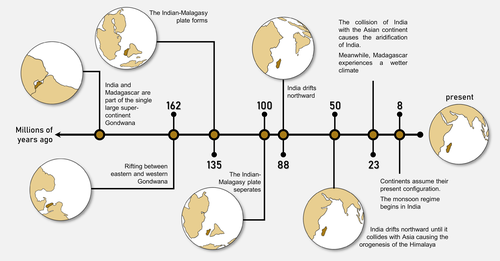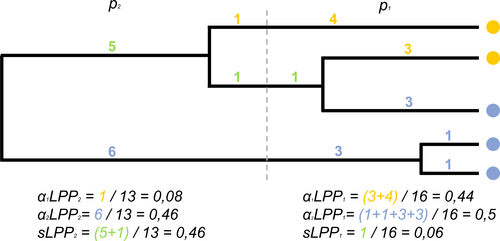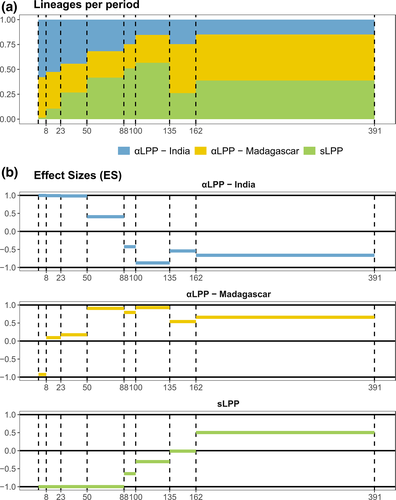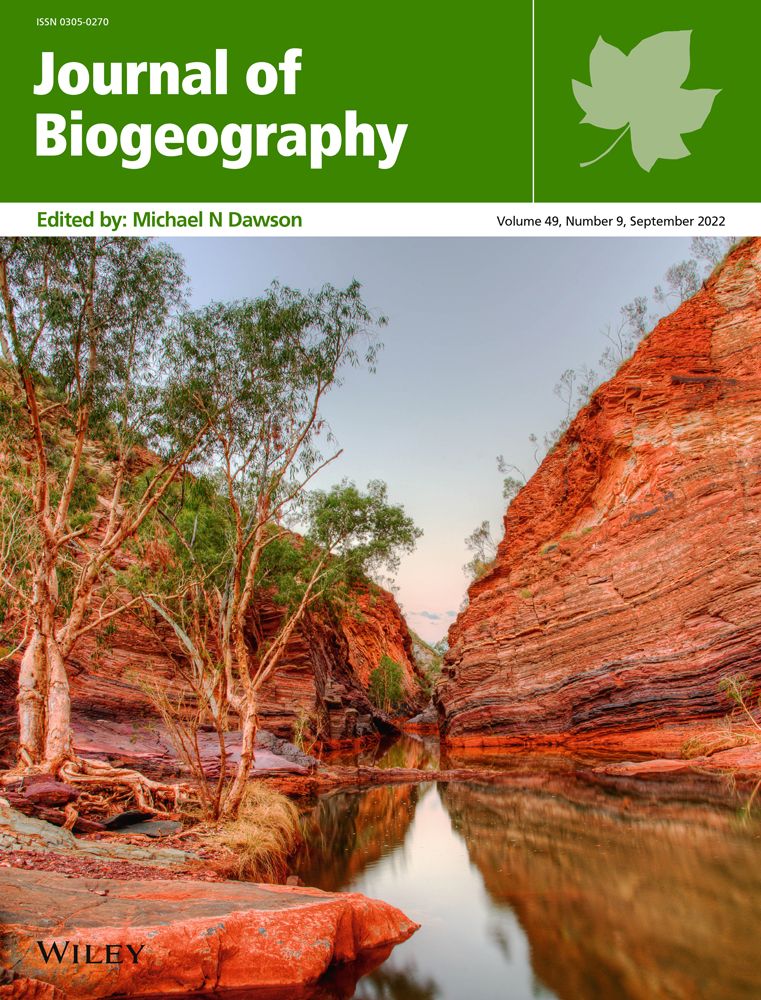Diversification and divergence of rainforest woody plants in South India and Madagascar relate to geomorphological history
Handling Editor: Sheri Fritz (geo)
Abstract
Aim
Indian and Malagasy tropical rainforests share a common history that dates back to the fragmentation of Gondwana. We partitioned phylogenetic diversity across historical periods to uncover how such continental displacement led to the divergence of lineages, through vicariance and/or independent migration from other regions, influencing extant phylogenetic composition.
Location
Madagascar and South India (Western Ghats).
Taxon
Woody vascular plants (tracheophytes).
Methods
Using a time-calibrated megaphylogeny, we partitioned the phylogenetic diversity of Indian and Malagasy tropical rainforest assemblages, across evolutionary periods defined based on milestone events in these regions of geological history. We decomposed the relative proportion of lineages with extant representatives in each area as well as in both areas, to quantify the common and separate biogeographical legacies in the two regions. We identified an excess or deficit of shared and unique lineages for each period and region.
Results
The proportion of shared lineages between Madagascar and India progressively decreased following the successive breakoff and isolation of Madagascar from the Indian-Malagasy plate. Lineages unique to India are more numerous than expected at random in more recent time periods, whereas, lineages unique to Madagascar were significantly more present in older time periods.
Main conclusions
The flora of Madagascar harbours a greater number of ancient lineages than does the Western Ghats, consistent with the higher number of endemic families and genera of trees in Madagascar. More recent diversification in India could be related to the collision of India with Eurasia, which enabled subsequent biological interchanges.
Significance Statement
We use a novel way to partition the shared and unique lineages in the phylogeny of rainforest woody plants of Madagascar and India. The variation of the partitioning across geomorphologically significant periods reflects how the separation and subsequent exchanges with neighbouring regions influenced the flora of the two areas.
1 INTRODUCTION
Indian and Malagasy tropical rainforests share a common history that dates back to the breakup of Gondwana circa 162 million years ago (Figure 1). Between 135 and 100 million years ago, India and Madagascar were a single island located c. 30°S (Yoder & Nowak, 2006). Some 20 million years later, India separated from Madagascar. During its northward journey, India experienced an equatorial climate that favoured tropical rainforests (Prasad et al., 2009; Shukla & Mehrotra, 2014). The meeting of India and the Laurasian Plate c. 50 million years ago began the Himalayan orogeny and caused a great drought of India (Briggs, 2003). This great drought confined Indian rainforests to smaller geographical areas, such as the Western Ghats on the western slopes of India (Gunnell, 1997) and some Himalayan foothills in the north (Karanth, 2003). During this time, the geological plate of Madagascar became attached to the African plate and caused the island of Madagascar to move slightly northward, between 10°S and 25°S. Prior to timeframes earlier than 40 million years ago (mya), Madagascar was likely protected from moisture coming from the Proto-Indian Ocean by the presence of India to its northeast and thus had a very dry climate. Only when India had moved further north did Madagascar have a wetter climate, resulting in the expansion of Miocene tropical rainforest, 50 to 40 mya (Yoder & Nowak, 2006). The monsoon regime began in India 8 mya, coincident with the rise of the Tibetan plateau (Yoder & Nowak, 2006; Yoshida et al., 1999).

The composition of extant plant assemblages is the outcome of contemporary ecological dynamics. In particular, human activities have shaped extant ecosystems as, for example palaeoecological, ecological and molecular data support that anthropogenic grassland recently replaced forest within the last millennium in Madagascar (Joseph et al., 2021). Extant forest composition still keeps tracks of the way taxa have evolved and diversified in a given region over the long term (Hubbell, 2001; Ricklefs, 2008). For instance an analysis of the relative frequency of lineages of different epochs in plant assemblages currently occurring in different habitats has shown that over- or under-representation of lineages in an epoch could reflect over- or under-diversification of taxa at this epoch (Bartish et al., 2016). There are different ways of decomposing and analysing the phylogenetic diversity across periods within assemblages (Pavoine et al., 2009, 2010; Skeels, 2019). The separation of the Indo-Malagasy plate from the rest of Gondwana would have favoured the isolation and divergence of India and Malagasy tree lineages, through vicariance (Toussaint et al., 2016) and independent input of taxa from other regions (Warren et al., 2010). Dipterocarpaceae—a major tree family that now dominates forests in India and South-East Asia—originated in the Malagasy-Indian plate and subsequently dispersed into Asia after India collided with the plate (‘out-of-India’ hypothesis, Ducousso et al., 2004; Dutta et al., 2011), while a vicariant sister family, Sarcolaenaceae, meanwhile differentiated and diversified in Madagascar. Despite the continental shifts that drove the physical separation and isolation of India and Madagascar, fauna capable of crossing small marine barriers may have maintained some connectivity between the two regions (Briggs, 2003) and with adjacent areas. Studies based on genetic data have highlighted the recurrent role of long-distance dispersal on the diversification and distribution of organisms (Cook & Crisp, 2005; De Queiroz, 2005). Furthermore, other lineages, such as the Memecylon genus in Melastomataceae with divergence times that are inconsistent with geographical separation events (Amarasinghe et al., 2021; Renner, 2004), emphasize the need to consider transoceanic migration events in elucidating the biogeographical history of these regions.
Here, we partitioned the phylogenetic diversity of tropical rainforest trees across evolutionary periods, based on milestone events in Malagasy and Indian geological history, so as to elucidate how this history has influenced the divergence and accumulation of lineages in the two regions. Specifically, we devised a method to analyse lineages that are unique or shared between Madagascar or India for a given evolutionary period. We expected there to be more shared lineages in periods when Madagascar and India were united, with the progressive separation and increasing distance between India and Madagascar resulting in decreasing numbers of shared lineages over time. We also expected there to be more unique lineages in Madagascar or India at periods when local diversification, vicariance and immigration prevailed.
2 MATERIALS AND METHODS
2.1 Indian and Malagasy tropical rainforest data
We used data of forest composition from Madagascar based on a national network of 753 plots covering the diversity of forest types along major environmental gradients. The inventories were conducted in 1995–1996 (Collectif., 1996) selecting only plots occurring in wet evergreen forests (303 plots). Plots were triangular with an 80 m side, in which six circular sampling units were considered. Trees over 15 cm DBH were counted, while smaller trees (between 3 and 14.9 cm DBH) were counted in smaller nested circles. We used a set of 96 1 ha forest plots in Karnataka, central Western Ghats, South India, in which all trees above 10 cm DBH were identified and counted between 1996 and 1997 (Ramesh et al., 2010). A map detailing the location of the plots is provided in Data S1 (Figure S1).
Based on these forest inventories, we used the time-calibrated megaphylogeny of Zanne et al. (2014), updated by Qian and Jin (2016), built from gene sequences of land plants to derive the phylogenetic relationships between species in both regions using the R package V.Phylomaker (Jin & Qian, 2019).
Any taxa present in India or Madagascar, but missing from the phylogeny, were added to the next genus- or family-level basal node.
We calculated metrics of taxonomic composition, that is the number of species in India and in Madagascar and the percentage of sampled uniqueness of species (number of species found only in one region relative to all sampled species), genera and families in each region.
2.2 Phylogenetic diversity per period
We defined eight historical periods based on biogeographical events relating to the gradual dislocation of Gondwana and subsequent climate regime shifts in India and Madagascar (Yoder & Nowak, 2006), that is 162, 135, 100, 88, 50, 23 and 8 mya (Figure 1). We took care to define periods with decreasing resolution in the past (i.e. longer ancient periods) so as to include sufficient lineages in each period to allow robust statistical analysis. Within each period, the summed branch lengths with extant descendants in both Indian and Malagasy communities were divided by the total branch lengths over each given period (see Figure 2). This accounted for the shared lineage history per period, further referred to as Shared Lineages Per Period (sLPP). Consequently, sLPP was bounded between 0 and 1 (where 0 means none of the branches in a given period have descendants from both India and Madagascar, and 1 denotes all branches have descendants from both India and Madagascar). In other words, a smaller sLPP indicates a period with a greater divergence between India and Madagascar.

We also used branch lengths with extant descendants unique to Indian or Malagasy communities to derive the αLPP in India and Madagascar respectively (so that αLPPIndia + αLPPMadagascar + sLPP = 1).
A detail of the code in R language used to compute the sLPP and αLPP for the above-mentioned time periods using the phylogeny and associated community data is provided in Data S4.
2.3 Null model-based testing
We designed a null model to quantify, as an effect size (ES), the extent to which observed sLPP values differed from their expected distributions if the phylogenetic distribution of global species was random across the two regions. This phylogenetic randomization was obtained by reshuffling species positions among the tips of the phylogenetic tree. Tree topology and branch lengths were unchanged by the randomization process. The resulting null model thus constrained the diversity of species per region by leaving the species by site matrix unchanged.
For each period, we compared the observed sLPP to the distribution generated by 999 iterations of these null models. ESs were computed based on the probability for the observed sLPP to be greater than expected under the null model and re-scaled to vary from −1 to 1. If the ES was close to zero, then the observed sLPP values were close to the median of the null distribution. More negative values implied that India and Madagascar share fewer lineages over a given period than expected by chance, and vice versa.
We also compared observed αLPP values for India and Madagascar to their distributions generated by 999 iterations of these null models and derived the associated ES. In this case, positive ES values implied that a given period included more unique lineages than expected by chance, and thus greater local diversification or input from external regions at this period.
2.4 Contribution of taxa to phylogenetic diversity per period
We quantified the contribution of families and genera to the sLPP and αLPP in India and Madagascar for each time period using the distance between the observed values and those computed while removing species belonging to said families and genera respectively. The larger the distance the more a given family or genus contributed to the metric of phylogenetic divergence per period.
We performed a Principal Component Analysis of the family and genera contributions per period and for sLPP and αLPP, to identify taxa that contributed the most to these metrics.
All analyses were performed using the R (3.6.3) statistical platform (R Development Core Team, 2010).
3 RESULTS
Table S1 summarizes the taxonomic composition of plots in India and Madagascar, and is provided in the Data S2 and S3.
The proportion of shared lineages between extant Malagasy and Indian rainforest plots progressively decreased from the dates of separation of the Indian-Malagasy plate (100 mya; Figure 3a). The associated negative ES values (Figure 3b) showed significant divergence after 100 mya—that is Madagascar and India shared fewer lineages than expected under the null expectation. Furthermore, our results showed a drop in the proportion of shared lineages (sLPP) following the separation of the Indian-Malagasy plate from the rest of Gondwana (at −135 Myr).

Negative ES associated with αLPP-India at earlier periods dropped between 100 and 135 million years ago then increased and became positive following the separation of India from the Indian-Malagasy plate and its subsequent journey north (between 88 mya until present). Thus, lineages unique to India were more numerous than expected at random in more recent time periods.
Conversely, positive ES values associated with αLPP-Madagascar started to decrease after the breakup of the Indian-Malagasy plate, specifically during India's northward drift (88 mya) and became negative after the Miocene (23 mya). ES values closer to 1 between 50 and 135 mya suggested that lineages unique to Madagascar were more extensive in these older time periods. The ES was highest after the collision of India with Eurasian plate c. 50 mya.
The two gymnosperm and one pteridophyte families (Podocarpaceae, Gnetaceae and Aspleniaceae respectively) contributed exclusively to the sLPP and αLPP values in periods older than 135 mya. The appearance of angiosperms 135 mya coincides with families from these groups showing greater contributions to sLPP and αLPP values in subsequent time periods (Figure 4).

Celastraceae, Meliaceae, Fabaceae, Annonaceae and Cannabaceae contributed substantially to the Indian αLPP values in geological periods after the collision of India with Asia (50 mya). Families, such as Staphyleaceae and Vitaceae, that were not found in Madagascar plots, contributed to lineages unique to India in earlier time periods (Figure 4a). Meanwhile, Canellaceae an older basal Angiosperm family strongly contributed to lineages unique to Madagascar (αLPP-Madagascar) at ancient periods, while the endemic family Asteropeiaceae contributed strongly to the Malagasy αLPP between 50 and 88 mya (after Madagascar's separation from India; Figures 4). Lauraceae, Salicaceae, Sapindaceae and Menispermaceae contributed to the αLPP-Madagascar in more recent periods (after 50 Myr).
Shared lineages that contributed the most to the observed patterns were the basal Angiosperms families, such as Lauraceae and Annonaceae. Shared lineage diversity was mostly driven in recent time periods by Rubiaceae and Apocynaceae families (Figures 4).
4 DISCUSSION
Using a dated phylogeny and a network of rainforest plots in the two regions, we found different patterns of phylogenetic diversity in India and Madagascar following their separation. Overall, our results showed that the phylogenetic divergence between Malagasy and Indian rainforest plots progressively increased following Madagascar's isolation from the Indian-Malagasy plate. Furthermore, unique extant Malagasy lineages dated from older periods while extant unique lineages in India were more recent. This ‘museum’ effect (Bartish et al., 2016) in Malagasy rainforest phylogeographical history was arguably driven by families of Gondawanan origin. For example Canellaceae yielded a number of extant taxa in Madagascar, notably the endemic genus Cinnamosma, which could not persist in or disperse to India after the separation from Madagascar. This effect could also have been caused by endemic families like the Asteropeiaceae, close to Theaceae, which could have differentiated by vicariance in Madagascar after its separation from the Indian-Malagasy plate 88 mya.
Our results show opposite trends for the diversification of the Indian flora following its separation from Madagascar, as the over-representation of more recent lineages in India rather suggests some ‘cradle’ effect (Bartish et al., 2016). Thus, taxa in the Malagasy flora could diversify earlier than those in the flora in the Western Ghats, which is consistent with the higher number of endemic families (Asteropeiaceae, Barbeuiaceae, Physenaceae, Sarcolaenaceae and Sphaerosepalaceae) and genera of trees and liana in Madagascar, while there are no endemic families of spermatophytes in Western Ghats rainforests. More recent diversification in India follows the collision with the Eurasian plate and suggests substantial immigration from Africa and Asia, with possible recent diversification in the Western Ghats. This is consistent with a high level of endemism in the Western Ghats at mostly infrageneric level. Colonization of African elements into the Indian subcontinent during the Plio-Pleistocene, especially of Fabaceae and Meliaceae taxa, has been reported based on fossil data (Shukla et al., 2013). Meliaceae are of western Gondwanan origin, and frequent dispersal shaped their present-day distribution (Muellner et al., 2006). Celastraceae form a spatially restricted group of taxa in South India that were able to drift with India after separation with Madagascar (Bacon et al., 2016).
Among the lineages that contribute the most to the shared LPP between India and Madagascar, some that evolved more recently support the hypothesis of long-distance dispersal, as has already been suggested for Clusiaceae (Ruhfel et al., 2016). Some shared recent genera could have diversified subsequently, producing many endemic species in each area (e.g. Memecylon, Diospyros). Some old families contributed to both shared lineages (e.g. Annonaceae and Lauraceae) and to lineages unique to India (Annonaceae) and unique to Madagascar (Lauraceae), suggesting both the museum and the cradle effects. Both India and Madagascar were able to retain groups inherited from primary Gondwanan forests (e.g. Beilschmiedia and Cryptocarya genera in Lauraceae, Polyathia complex in Annonaceae), and our results support the possible colonization of Annonaceae in Asia from India (Doyle & Le Thomas, 1997). On the other hand, long-distance dispersal might have played a role in establishing extant patterns of Annonacaeae (Richardson et al., 2004), as suggested by the recent discovery of a disjunct representative of the African Friesodielsia genus in India (Page & Surveswaran, 2014).
We compared the composition of mature rainforest plots and considered these as a representative, conserved and unmanaged sample of Indian and Malagasy tropical rainforest biodiversity. However, substantial anthropogenic impacts are likely to have blurred the long-term biogeographical signals in phylodiversity. We selected forest plots situated in more natural ecosystems to limit an influence of recent inputs in managed and planted forests, yet the plot-based sampling could also undersample native woody biodiversity in the two study areas. Ongoing initiatives to provide checklists of rainforest biodiversity with accurate information on the biogeographical status (e.g. TreeGhats in South India [Raevel et al., 2017]) should enable the scope of future research to be extended.
In this study, we devised a new method that allowed us to partition the phylogenetic diversity of tropical rainforests not among the nodes of a phylogeny (Pavoine et al., 2009) but across defined evolutionary periods based on milestone events in the geological history of one or more regions, so as to uncover major changes in diversification and migration pathways. Future perspectives could make use of this approach to decompose trait diversity (Pavoine et al., 2010) across geological periods to examine trait evolution in relation to past environmental changes.
ACKNOWLEDGEMENTS
No collecting permits were required for this research. We thank Pr. B.R Ramesh for stimulating discussions on the biogeography of the Western Ghats and Madagascar. We warmly thank Ghislain Vieilledent and Jean-Roger Rakotoarijaona for having digitized and made available the data of forest inventory in Madagascar.
CONFLICT OF INTEREST
The authors declare that the research was conducted in the absence of any commercial or financial relationships that could be construed as a potential conflict of interest.
Open Research
DATA AVAILABILITY STATEMENT
The original contributions presented in the study are included in the article/supplementary material. Malagasy forest census data used in this study were obtained from the Inventaire Ecologique Forestier National, while Indian forest census data on which the analyses of this study were based are available at https://doi.org/10.6084/m9.figshare.c.3303531.v1
REFERENCES
BIOSKETCH
Elizabeth Barthelemy's interests centre around biogeography and eco-evolutionary modelling. This work represents a component of her PhD work at Université Grenoble Alpes on the influence of past environmental fluctuations on the current diversity of tropical rainforest trees.
Authors' contributions: Elizabeth Barthelemy and François Munoz contributed to the design of the study. Elizabeth Barthelemy performed the analysis and wrote the first draft of the manuscript. Elizabeth Barthelemy and François Munoz contributed revisions to the manuscript and all authors gave final approval for publication.




